Product Naming: Invisibelt
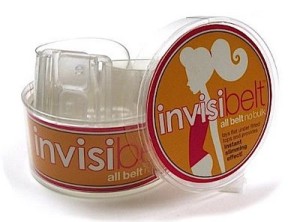
Love this product. Love the name just about as much. While it's reminiscent of my school-girl dreams of becoming Wonder Woman one day (yes, it was a gold belt but an invisible plane), this product meets the needs of women on so many levels. No longer having to choose a traditionally bulky accessory, gals can keep their fashion integrity while still maintaining comfort and style.
The manufacturers of the Invisibelt could have gone a lot of different directions when deciding on a name - trendy, obscure, arbitrary. Instead, they spoke to form and function. Nice job being clever with a descriptive name.
When does a Newly-Merged Portfolio become a “Dysfunctional Family?”
There is always excitement and discomfort with change. Your portfolio of products or services may change gradually through organic growth or expand suddenly due to a merger or acquisition. There is a prayer you can manage portfolio change with care in the former case, but sudden growth always raises key challenges.
When Portfolios Merge
There is usually a sound business strategy behind a corporate merger. This could include expanding an identical product or service into an enlarged geographic footprint or expanding an array of products within the same general product category. The closer the add-on products are to the original, the easier it will be for company employees and customers (new and merged) to embrace the new products.
However, let’s consider the corporate combination (whether small or large scale) that introduces whole new categories of merchandise or service to the buying audiences of both former entities. Now HERE’s where internal AND external brand positioning mind-bending can occur.
Questions can start to creep in that could well affect the overall corporate brand, its place in the cosmos, its reason for being. This may sound overly dramatic, but altering a portfolio mix will have a direct functional impact on every level of the organization. Some might be minor, like adding a few pages to a catalogue or web site, or redrafting the organizational chart. But, unless strategic clarity is applied to the change, the rationale and subsequent merger execution could also never quite congeal with employees and customers.
Who Needs to Know What
WHY did this merger happen, to whom does it make the most sense, who benefits and how? A logical explanation must be given to all employee groups. And not just once, but as an ongoing reminder to sustain the pain of adjustment they will be enduring. You can simply call it vigilant internal communications, but, for it to be truly successful, it should really be a long term, internal MARKETING campaign. Nothing less than the integrity of the overall, master brand is at stake.
Certainly, external audiences, especially all current and potential customer groups, should receive clear and consistent messages about why these new products are now part of the corporation’s offering. It should be seen as a rationally expanding family group, with next to none of the externally visible dysfunction any newly-blended family inevitably experiences.
Going Forward
THEN, how you avoid purchase decision-making confusion or paralysis from that point on has a lot to do with how the portfolio is structured and how products are named. Pay close attention to what everything is called. If names need to change, allow adequate time for all involved to absorb and become familiar with the change. Blending companies is just as delicate a task as merging families… just a heck of a lot larger!
Contributed by Bev Brandt
Product Naming Spotlight: The Transition
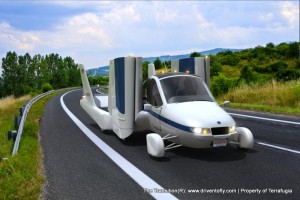
It's a bird ... it's a plane ... it's a car. Actually, it's two out of three: a plane that transitions into a road-use vehicle. Hence the name: The Transition.
For pilots, simply land at the airport, fold your wings up and drive home.
I appreciate the simplicity of the name selected by the manufacturer, Terrafugia. Appealing to the pain point of pilots who face a dilemma of transportation once they land their aircraft, the name speaks to the benefit of 'transitioning' from plane to road vehicle.
The company could have chosen a more unique approach; after all, this is basically the FIRST flying car. Are they leaving open space for future manufacturers to own the category with a more memorable name (think what Swiffer did to the sweeping/mopping category)? I'm not sure. With close to a $300,000 price point, I think they're pretty safe in the space right now.
Everything I Need to Know About Branding I Learned from College Football
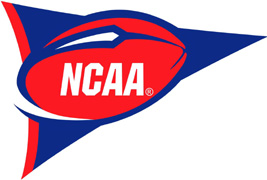
Remember the adage everything I need to know I learned in kindergarten? Well let's think about this in terms of branding; that sentence could easily translate to everything I need to know about branding I learned from college football.
As I've written about in a number of past posts creating a memorable brand experience and creating a strong brand loyalty are the hallmarks of a successful brand, and nowhere will you find a company or product that creates the undying passion and loyalty the way college football teams do.
Point-in-case: When I originally started to write a post tying branding and college football together I was going to list the top ten college football brands (admittedly determined by my own biased ranking system) but quickly decided this was a bad idea based on a number of things.
- Problem #1: The thought of ranking my favorite team (Go Gators!) at anything other than #1 made my skin crawl.
Problem #2: SEC schools would undoubtedly take over the top five (heck the entire top ten would probably be SEC schools in my mind) because in addition to being a Florida fan I'm an SEC fan.
Problem #3: Last but certainly not least, I knew that if I started ranking college teams a debate so heated would break out in the office that I feared our walls would come crashing down like goal posts of yesteryear.
So how do college football teams garner such strong brand experiences and loyalty? It's because when it comes to branding, college football gets it. There is a painstaking attention to detail associated with a college football brand from making sure the correct Pantone color is used for every piece of equipment, apparel and brochure to guarantee consistency to nostalgic activities that create positive brand associations. These nostalgic activities can include a school's unique tailgating traditions and pre-game ceremonies. Every detail is considered, and everything is branded.
But why would a school spend so much time, energy, and money to create these branded experiences? It's simple. A school with a strong brand will continue to attract masses of new students each year (subsequently growing its brand's reach every year), students then graduate, become alumni and alumni become donors to the school. Finally there is the revenue and brand impressions generated from trademark licensing. Schools like the University of Texas, University of Florida, University of Michigan, University of North Carolina, etc. generate millions of dollars each year from licensing revenue alone. The number of impressions brands like these get each year from the sale of licensed apparel and equipment only furthers the awareness and loyalty for brands.
Having a strong brand in college football is more than winning games because even in recent slumps of some the greatest brands in college football their fans have remained true and passionate. It's all about the experience and the passion the fans feel for their brand…I mean team.
So repeat after me: everything I need to know about branding I learned from college football.
The Good, The Bad & The Bizarre of Brand Extensions
Once upon a time Coca-Cola had only soft drinks, Burger King only had burgers, and Nokia had rubber boots…
Yes, you read that correctly. The same Nokia that has been a telecommunications company and long time mobile phone manufacturer started out as an industrial conglomerate that produced galoshes and other rubber products.
Other than having strong and highly recognizable names these companies along with many others have tried their hand at extending their brand beyond their individual flagship products. Brand extensions are a complex venture and run the chance of being either highly successful or horribly awful.
Unlike product extensions which are the use of a brand's name for a new item in the same product category, a brand extension is a strategy deployed when a company uses their brand name and attaches it to a new product in a different product category from the original established product. Much like Starbucks did when they introduced their liquor line in addition to their signature coffee.
Attaching a brand name to a new product category allows marketers to capitalize on the brand equity of the original brand and attach it to something new in hopes that consumers will associate the same experience and knowledge they have of the brand to the new product. But attaching a brand name to a new product is not always easy, it can be costly for both the brand extension and original brand because a poor choice for brand extensions may dilute and deteriorate the core brand and damage its brand equity.
When a brand extension is successful it can prove to be a lucrative move for brands, and in some instances like Nokia the brand extension becomes more successful than the original venture. But sometimes brand extensions are just flat out weird. So, which are which? Take a look at the graph below and see some brand extensions I've laid out as the good, the bad, and the bizarre.
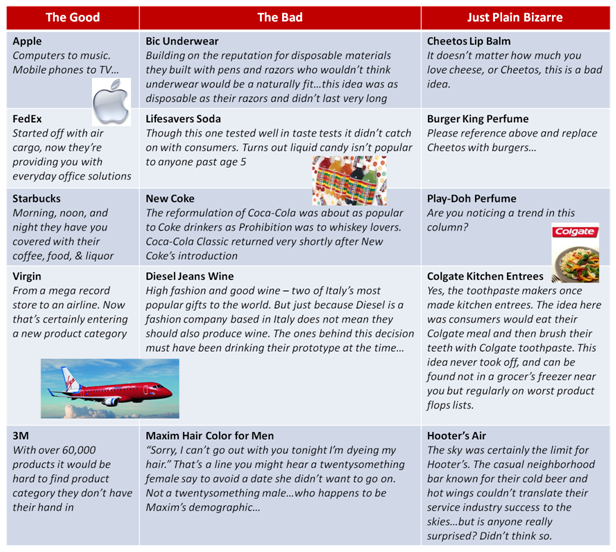
What is Employer Branding?

It’s easy for you to start talking about the products or services your company offers, but how do you talk about your company itself? It’s not enough to promote one of your own brands, companies must brand themselves as employers.
Brett Minchington, Chairman/CEO of Employer Brand International, defines your employer brand as “the image of your organization as a ‘great place to work’ in the mind of current employees and key stakeholders in the external market (active and passive candidates, clients, customers and other key stakeholders). The art and science of employer branding is therefore concerned with the attraction, engagement and retention of initiatives targeted at enhancing your company's employer brand."
Companies brand themselves as employers to convey to the world why their workplace is appealing in hopes of attracting good workers, which is especially important during the economic slowdown. As companies cut costs, getting the best people in the right jobs is even more crucial. Additionally, as companies expand into foreign markets competition for skilled workers increases.
While there are many ways to approach employer branding, one of the most important things is knowing who you are. Create a brand based on your company’s mission and objectives. The book Built to Last: Successful Habits of Visionary Companies demonstrates that companies with consistent, distinctive and deeply held values tend to outperform those companies with a less clear and articulated ethos. Product lines, profit strategies, cultural tactics, and organization structure can change – but a core ideology should not.
Your employer brand is who you are, and how others—both employees and potential candidates -- view your company. Communicating your organization's mission and values will attract and engage the like-minded talent who will directly affect your bottom line.
Same Product, Different Name


You're making a sandwich and go into your fridge to pull out a jar of Hellmann's Mayonnaise...or is it Best Foods? Well, it depends where you are making this sandwich. If you live east of the Rockies, you're spreading Hellmann's Mayonnaise on your bread. But, move west of the Rockies and you're using Best Foods.
Both brands have similar logos, websites and even taglines. Seems strange doesn't it? So, why would a company create or give a different brand name for the same product in a different geography? We've compiled some common reasons you may find identical products with differing names.
MERGERS and ACQUISITIONS: It is not uncommon for mergers or buyouts to occur. Despite an acquisition, many brands are well-known--sometimes even better-known than the new parent brand-- and retain strong brand equity. When the name of national brand is strong, the original name is often kept, even when an international visual identity is adopted. The same applies on local or regional levels. For example, when Richard Hellmann Inc. was acquired by Best Foods, Inc., Hellmann's Mayonnaise sold east of the Rockies and Best Foods Mayonnaise sold west.
LEGAL: Whenever you create a name, there is always the possibility that someone else somewhere else has already thought of it. Often a local brand already owns the legal right to use a name, forcing a multinational company to create another name. This is particularly true in the pharmaceutical industry, which is why the same medication may have a different name in France than it does in the United States.
LANGUAGE: Words and phrases translate differently into different languages. Sometimes a brand's name may be inappropriate or even misleading in a specific language, potentially hurting sales. Depending on the product it can be funny, or it can be horribly ironic; one example of both these instances is the Chevy Nova. “No va” in Spanish means doesn’t go…perhaps not the best name for a car.
How do you avoid any naming mishaps in different regions? Research is essential in developing a name with long-term staying power. Copyright and trademark screening will eliminate name candidates in existence and linguistic evaluations will ensure you not cursing out someone's mother in another country. Doing research ahead of time will save you the time and money early on if you find your name already exists, and may even spare you embarrassment overseas.
Brandverbs: The Highest Mark of Success?
When was the last time you said: "I'm going to go use a search engine to look up information on tonight's event." The answer to that is either never, or sometime circa the early 2000's, but since then it's more than likely that most Americans say "I'm going to go Google more information on tonight's event." And that is my friend is brandverbing.
Companies like Xerox, Hoover, and even Google have gone to great lengths to avoid their brands becoming verbs, but why? When a brand becomes a verb you know that it has reached mass market consumer recognition, so wouldn’t becoming so engrained in society that your brand becomes part of the language be the ultimate degree of success for a brand?
So while others have fought hard to keep their brand from becoming a verb others are spending a lot of time and resources to make sure their brand is used as verbs by consumers in everyday life and conversation. Enter: Vanguard; an investment company who in 2010 began a highly visible campaign to turn their brand name into a verb.
The move by Vanguard shows that they too recognize the significance and potential payoff for their brand to be used in everyday language just like Xerox or Google has now experienced. And unlike a brand becoming genericized like asprin, zipper, and escalator (yup, these were all trademarked brand names at one point) a brand that becomes a verb is more appealing than its generic counterpart and has less risk in losing its brand appeal. Seth Godin, American author and speaker, said: "people care much more about verbs than nouns. They care about things that move, that are happening, that change. They care about experiences and events and the way things make us feel. Nouns just sit there, inanimate lumps. Verbs are about wants and desires and wishes."
So if what Godin says is true, every brand should strive to be a brandverb when appropriate. After all a brand is more than a product or logo, a brand is about an experience and the expectations we have of that brand. So if becoming a brandverb will incite those feelings then what's the big deal? These days I believe becoming a brandverb is not a kiss of death but the mark of success.
How Social Media Can Help Branding
Social media is a great way to help promote a brand because of convenience and connection. Social networks are unlike other marketing platforms because they offer brands an easy access to target audiences, and the ability to maintain online relationships. An online brand profile allows a company to introduce its brand identity, and make the brand more present in consumers’ everyday lives.
The biggest platforms that will help bring the most traffic to a brand are Facebook, Twitter, and Linkedin. Facebook offers a limitless amount of space to promote a brand, with room for wall conversations, updates, photos, video, pictures, interests, and more. Though Twitter and Linkedin are a bit more limiting in what you can share with your audience, they are equally as powerful as Facebook for engaging interaction and forming an online identity.
Consistent updates on Twitter, Facebook, or Linkedin will help flesh out your brand’s profile. Followers can learn about news updates, comment on posts, and offer other insights that may help your brand be the best it can be. The unique quality about social networks is that they build a community and thus a loyalty around your brand, which is valuable for staying relevant and attractive in any industry.
One of the most valuable things social media has to offer a brand is the ability to associate with other brand names online. Partnerships can increase visibility to a wider audience, and leverage a brand into new markets. Alternatively, if a brand targets a specific market or a certain audience, there are niche social media sites to explore. For example, if your brand is a diaper company, it would be advantageous to follow or even start a mommy blog, to get feedback on what mom’s think about your products.
In the past, brands have just been names and logos, but now they trigger online conversations, bringing more life and interaction to a brand’s identity. Not only can you see what consumers say about your brand, but also what they say about competitors. Following a competitor’s profile page can help a brand to monitor the direction of its competitor, and stay up-to-date in the market.
In a brand-centric world, social media can really help a brand distinguish itself and maintain a fresh image. The social media-scape is still new, allowing room to innovate the ways in which it’s being used. We should be seeing some interesting social media initiatives from brands in the near future!
Contributed by: Emily Hassell
Nice Package: 5 Tips for a Great Package Design
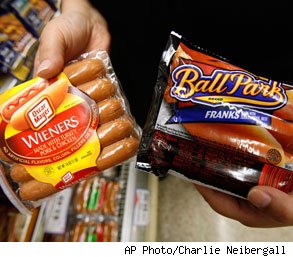
As "the hot dog wars" battle on between Sara Lee Corporation and Kraft Food Inc. in a Chicago courtroom over misleading package designs, I think it's time to take a deeper look into packaging and why it is important enough for these two companies to battle it out in court.
While a brand must employ a successful strategy throughout many different touch points including advertising, identity, and web presence, it is packaging that could most directly have an impact on a brand's sale. No longer is a product's package merely a means of protection during transport from point A to point B, but an increasingly important factor in product's success. A well-marked package will get a customer to pick up a product and take a closer look, which ultimately puts you one step closer to making that sale. This is why it is so important to have an interesting and compelling package design.
Kristin Everidge, Manager of Visual Branding at Addison Whitney, says "People are drawn to products with interesting packages because it suggests that what's inside is equally appealing or different." Package design can enhance a brand through unique structures, sustainable materials, cross promoting other products and building brand awareness through shelf displays and planograms that wow consumers during their weekly shopping trips.
Packaging is a vehicle that reflects the product's brand and image. To ignore the importance of packaging in today's market is your own product's death. Package design should be a continuous investment to evolve with the ever changing world that is packaging.
But what makes a great design? I asked Kristin and these are her top five elements of a great package design (in no particular order):
- 1. Shelf Presence/ability to grab attention quickly
2. Effective informational hierarchy
3. Inspiring materials and structure
4. Functionality
5. Clean & crisp design (images, typography, and functional information)
So do you think you're immune to the power of package design? I think the real answer would surprise you, next time you're shopping the aisles of your local Target, take note of the products you grab and how compelling their designs are compared to the products you left behind…
